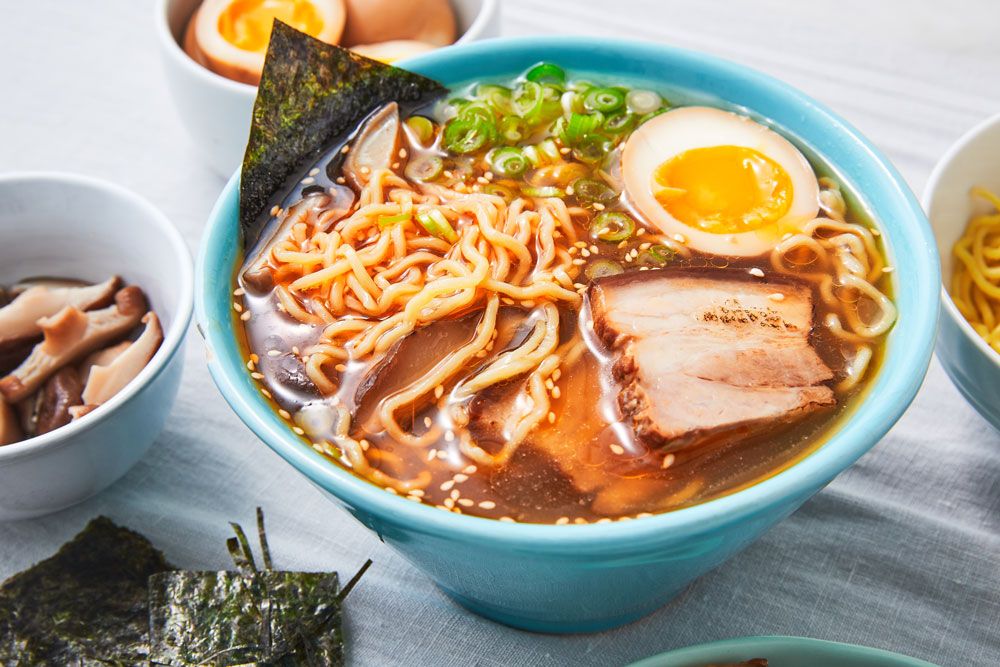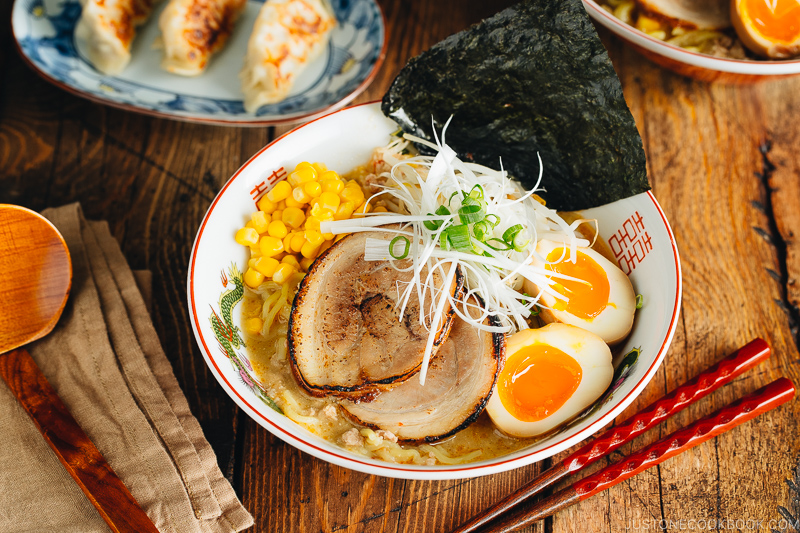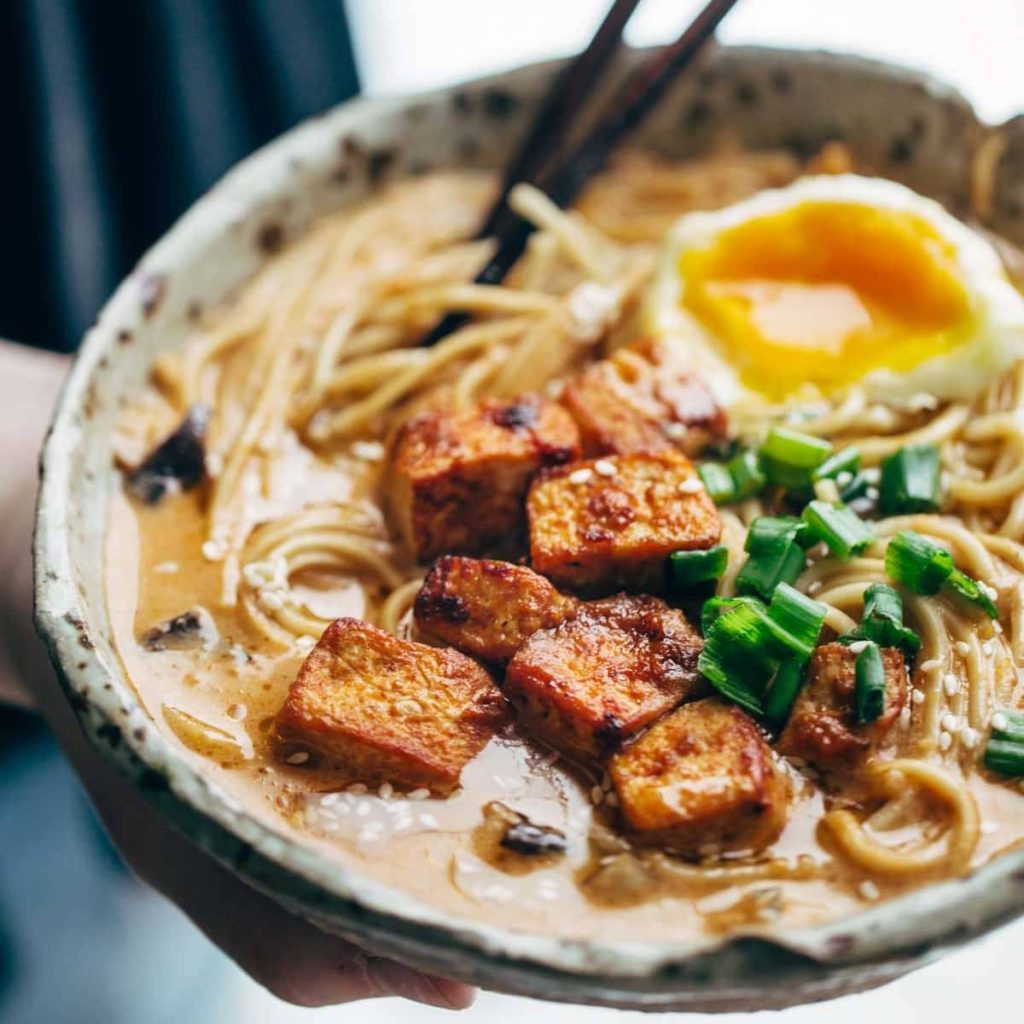Japanese Miso Ramen is a popular and flavorful dish that showcases the umami-rich taste of miso paste. This soul-warming bowl of noodles features a savory broth, chewy noodles, and an array of delicious toppings. The secret to a truly authentic and delicious Miso Ramen lies in the balance of flavors in the broth, achieved by combining miso paste with other ingredients such as soy sauce, mirin, and dashi. The noodles should be cooked to perfection, neither too soft nor too firm, and the toppings can vary from sliced pork, tofu, seaweed, bamboo shoots, and green onions. With its comforting and satisfying qualities, Japanese Miso Ramen is a culinary delight that will transport you to the bustling ramen shops of Japan.

Japanese Miso Ramen
Ingredients
Equipment
Method
- Heat a large pan.
- Add the miso paste and the rest of the ingredients into the mixture.
- Cook the ingredients for ten minutes.
- Add the ramen into the mixture once the sauce is ready.
- Mix the ramen well.
- Cook the dish for five minutes.
- Add the cilantro into the dish.
- Your dish is ready to be served.
Video
Notes
FAQs
Q: What is miso paste, and where can I find it?
A: Miso paste is a traditional Japanese ingredient made from fermented soybeans, rice or barley, salt, and koji (a type of fungus). It has a savory and slightly salty flavor, and its intensity can vary depending on the type of miso. Miso paste can be found in most Asian grocery stores or the international section of well-stocked supermarkets. It is usually sold in tubs or packets and comes in different varieties such as white (shiro), red (aka), and mixed (awase) miso.
Q: Can I make Miso Ramen without meat?
A: Absolutely! Miso Ramen can be made without meat by using vegetable broth or a combination of vegetable and mushroom broths as the base. You can also add tofu, mushrooms, seaweed, and other vegetarian-friendly toppings to enhance the flavor and texture of the dish. The miso paste itself provides a satisfying umami taste that complements the vegetarian elements.
Q: Can I adjust the spiciness level of Miso Ramen?
A: Yes, you can adjust the spiciness level of Miso Ramen according to your preference. If you prefer a spicy kick, you can add chili oil, chili paste, or sliced chili peppers to the broth. Alternatively, if you prefer a milder version, you can omit or reduce the amount of spicy ingredients and focus on the other flavors in the dish. Adjusting the spiciness allows you to customize the ramen to your liking.

Q: Can I use store-bought ramen noodles for Miso Ramen?
A: While store-bought ramen noodles can be used in a pinch, for the most authentic and flavorful Miso Ramen, it is recommended to use fresh ramen noodles. Fresh noodles have a chewier texture and absorb the broth better, enhancing the overall experience. You can find fresh ramen noodles at Asian grocery stores or specialty food stores. If fresh noodles are not available, opt for high-quality dried ramen noodles instead.
Q: How do I store leftover Miso Ramen?
A: If you have leftovers, it’s best to separate the noodles, broth, and toppings before storing them. Place the noodles in an airtight container, cover them with a bit of broth to prevent them from drying out, and refrigerate. Store the broth separately in airtight containers. The toppings should also be stored separately in sealed containers. When you’re ready to enjoy the leftovers, reheat the broth and noodles separately and assemble the ramen just before serving.
Cooking tips
1. Use high-quality miso paste: The quality of miso paste can greatly impact the flavor of your Miso Ramen. Opt for a good-quality miso paste to ensure a rich and authentic taste.
2. Don’t overcook the noodles: Cook the ramen noodles according to the package instructions, but be careful not to overcook them. Mushy noodles can affect the overall texture of the dish. Aim for a slightly firm and chewy texture for the best results.
3. Customize the broth: While miso paste forms the base of the broth, feel free to customize it according to your taste preferences. Add soy sauce, mirin, sake, or other seasonings to adjust the flavor and create a well-rounded broth.
4. Enhance the toppings: Experiment with different toppings to add variety and depth to your Miso Ramen. Consider options like sliced pork, soft-boiled eggs, bamboo shoots, nori seaweed, corn kernels, bean sprouts, and green onions. Don’t be afraid to get creative and try new combinations.
5. Control the saltiness: Miso paste can be quite salty, so be mindful when seasoning your broth. Start with a small amount of miso paste and taste the broth before adding more. You can always add more miso if needed, but it’s difficult to reduce the saltiness once it’s too strong.

6. Garnish with finesse: Presentation matters, so take the time to garnish your Miso Ramen beautifully. Arrange the toppings in an appealing manner and sprinkle some sesame seeds, chopped green onions, or chili flakes on top for added visual appeal.
7. Serve immediately: Miso Ramen is best enjoyed when served hot and fresh. Once you have assembled the noodles, broth, and toppings, serve the ramen immediately to prevent the noodles from becoming soggy and the broth from cooling down too much.
8. Make extra broth: Consider making a larger batch of broth and storing it in the refrigerator or freezer for future use. This way, you can easily whip up a bowl of Miso Ramen whenever the craving strikes, saving time and effort.
9. Experiment with miso varieties: There are different types of miso paste available, such as white (shiro), red (aka), and mixed (awase). Each variety has its own distinct flavor profile. Try different types of miso paste to find your preferred taste and to add variety to your Miso Ramen.
10. Enjoy the process: Making Miso Ramen from scratch can be a fun and rewarding experience. Embrace the opportunity to explore the flavors and techniques of Japanese cuisine. Adjust the recipe to suit your preferences and enjoy the process of creating a delicious bowl of Miso Ramen that satisfies your taste buds.
Serving suggestions
1. Traditional presentation: Serve the Miso Ramen in large bowls, with the noodles and toppings arranged neatly on top of the broth. Garnish with sliced green onions, nori seaweed, and a sprinkle of sesame seeds. Place a spoon and chopsticks alongside the bowl for an authentic dining experience.
2. DIY Ramen bar: Set up a ramen bar where everyone can customize their own bowl of Miso Ramen. Provide a variety of toppings such as sliced pork, soft-boiled eggs, bamboo shoots, bean sprouts, corn kernels, and shredded nori seaweed. Offer different condiments like chili oil, sesame oil, soy sauce, and vinegar for guests to enhance their ramen according to their preferences.
3. Bento box-style: For a portable and visually appealing serving suggestion, pack the Miso Ramen in a bento box. Place the noodles, broth, and toppings in separate compartments to maintain their individual flavors and textures. This option is great for picnics, lunch on the go, or a creative twist on serving at home.

4. Family-style sharing: Serve the Miso Ramen in a large, communal bowl at the center of the table. Allow everyone to help themselves by ladling the broth and noodles into their individual bowls. This style encourages interaction and sharing among family or friends.
5. Soup and side dishes: Pair the Miso Ramen with traditional Japanese side dishes for a complete meal. Serve a small plate of gyoza (dumplings), tempura vegetables, or a simple cucumber and seaweed salad alongside the ramen. The combination of flavors and textures will provide a well-rounded and satisfying dining experience.
6. Seasonal twist: Consider incorporating seasonal ingredients into your serving suggestion. For example, during the summer, you can add fresh herbs, sliced radishes, or cherry tomatoes as toppings to bring a refreshing touch to the Miso Ramen. In the winter, try adding steamed winter greens like kale or bok choy for added nutritional value and heartiness.
Remember, Miso Ramen is a versatile dish, and you can adapt the serving suggestion to your personal preferences and creativity. The key is to present the dish in an inviting and visually appealing manner that enhances the dining experience.








